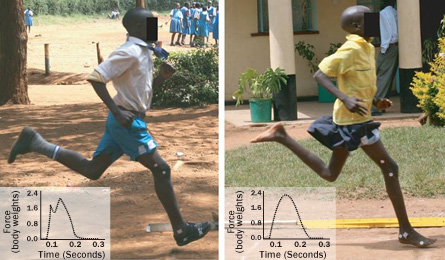Running barefoot blunts foot’s force
Going shoeless tempers impact, but effect on injuries uncertain
- More than 2 years ago
The clothes don’t make the man, but wearing no shoes might make the runner. A study of people who habitually run barefoot shows that these runners’ feet strike the ground in a way that tempers impact forces and smoothes the running movement, a study appearing online January 27 in Nature finds.

Although the results suggest that barefoot running might have benefits, it’s too early to say whether this running style is less likely to cause injuries, the researchers say.
The new study is “really elegant and well done,” comments Daniel Schmitt, an evolutionary anthropologist at Duke University. The finding is a “clear, good example” of the mechanics of different running gaits, he says.
“One shouldn’t be scared of barefoot or minimal shoe running or think it odd,” says study coauthor Daniel Lieberman of Harvard University. “From an evolutionary perspective, it’s normal and, if done properly, it is very fun and comfortable. We evolved to run barefoot.”
Earlier studies have suggested that people running barefoot land on the front or middle of the foot first, before lowering the heel and transitioning body weight to the back of the foot. The invention of the springy running shoe in the 1970s, the authors write, allowed runners to comfortably land on the heel first before rolling their weight forward on the foot. Shoe cushioning distributed the impact force, making the heel strike bearable. (Sprinters run primarily on their forefeet, but the mechanics of sprinting are different.)
Lieberman and colleagues traveled to the Rift Valley Province in Kenya and videotaped the movement styles of some famed endurance runners who grew up not wearing shoes. The researchers found that, as expected, these runners typically strike the ground with either the forefoot or the midfoot before lowering their heel. In contrast, shod runners in the United States typically landed on the heel first.
“This study is unique in that they actually went and found people who have been running barefoot and are world renowned as barefoot runners,” comments biomechanist Reed Ferber of the University of Calgary in Canada. Previous studies focused on people asked to run barefoot for the first time during laboratory experiments, he says.
In additional experiments conducted at Harvard, Lieberman’s team used a scale called a force plate to precisely measure force from running. The average initial impact force in habitually barefoot U.S. runners who land on the forefoot first is approximately one-third the force in shod U.S. runners who land on the heel, the researchers found. “A rear-foot strike is like someone hitting you on the foot with a hammer with about one and a half to three times your body weight. It would hurt without a shoe,” Lieberman says. “A forefoot strike is like having no one hit you at all.”
The team found that the ankles of these barefoot U.S. runners are more flexible than those of the heel-striking shoe wearers. That flexibility may be protective against stress injuries common in running. “The stiff landing hurts,” says Lieberman.
So far, there is no good evidence yet of whether barefoot running causes fewer injuries than does running with shoes, says Ferber. The idea that barefoot running is superior “is a massive assumption,” he says. “Fundamentally, there are no studies out there that show barefoot running is less injurious.”
Ferber points out that barefoot running also has its drawbacks. Landing on the forefoot can cause runners to flex the foot in a way that creates more mincing steps, shortening the stride, he says. In his studies, a six-foot, two-inch–tall man would have to take 7,500 more steps to finish a marathon if he was running barefoot than if he was running in shoes, because the length of the stride is shorter. “You could argue that if he’s going to take 7,500 more steps he’s more likely to get an injury,” Ferber says. “But you could also argue that all those steps don’t have that impact peak, so that might be injury protective. So who really knows at this point?”
Lieberman agrees that it’s too early for people to throw out their fancy shoes. “It’s too complex a question, as it depends on one’s feet, condition, ability to forefoot or midfoot strike, which takes more calf muscle, and so on,” Lieberman says.






